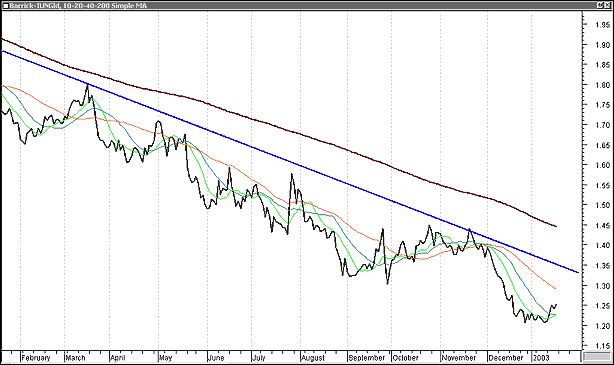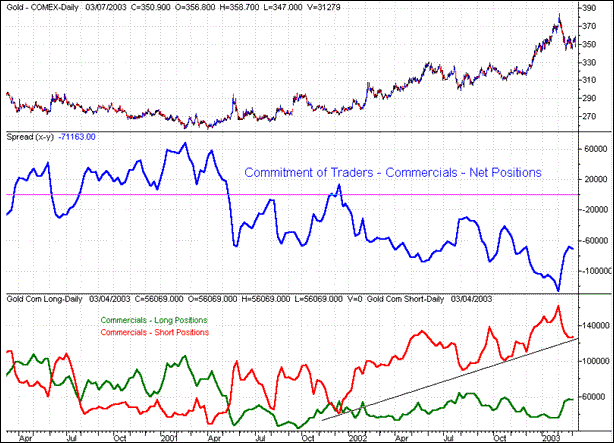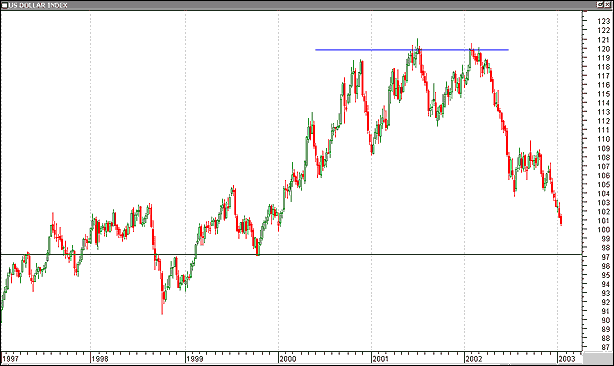| When it comes to the precious metal, Mr. Gold, also known as James Sinclair, chairman and CEO of Tan Range Exploration Corp. (TNX-TSX), is rarely wrong. In 1977 he predicted that gold would move from the current price of $150 to $900. The price fell slightly short of his goal when it hit $887.50 on January 21, 1980. He unloaded his entire gold position the next day, netting a cool $15 million, according to a December 10, 2001, Forbes article. He then predicted that the Federal Reserve's inflation fight would cause the price of the metal to languish for 15 years. Again, he was close; the price of gold bottomed in 2001. At the time of the Forbes article, he stated that speculator short-covering would occur when the metal hit $305 again, driving the price to $350 and possibly as high as $430. Five months later in April 2002, gold moved above $305, retraced below that price briefly in July, and then hit the $350 target on December 30, 2002, a little more than a year after his prediction (Figure 1). 
Figure 1: Comex gold (weekly). Here you see the weekly Comex 100 Gold Composite (CMX) since 1996. Note the low of $252.90 hit in July 1999, the $305 level and $350 levels predicted by James Sinclair. Whether the price hits the final target remains to be seen, but if his past record is any indication, the odds are that he'll be on the money again. How long will it take for his latest prophecy to come true? Before examining that question, it is essential to understand the forces that have come together to propel gold to 20-year highs. James "Mr. Gold" Sinclair proffers a number of factors, which he believes are now working together to cause this meteoric rise. GOLDEN FUNDAMENTALS Here are the fundamental reasons behind surging gold prices, according to Sinclair: - A declining US dollar. Reasons for the currency's decline include a ballooning current account deficit, government deficit, and the increased production of dollars being printed at the presses. A major portion of the current account deficit statistic is the trade deficit, which set yet another record of $40 billion in December 2002 (more than 5% of Gross Domestic Product on an annualized basis). As the largest debtor nation in the world, the US must continually fund this deficit with foreign investments. If foreign investments decline, the Fed may have no choice but to raise interest rates to help stem the flow. If it does so, the economy will be the victim. A falling dollar makes it less attractive to invest, making gold more attractive in the process.
- Mistrust of government/fiscal mismanagement. What is good for governments is generally bad for its people. Taxes are a great example. Taxes rise to support larger governments, which leads to more taxes. Inflation is the result of deficit spending by governments causing them to print more money and raise taxes even further. But it appears that governments have failed to learn from past misdeeds. As Alan Greenspan once said, long before his days as Federal Reserve chairman: "Deficit spending is simply a scheme for the 'hidden' confiscation of wealth. Gold stands in the way of this insidious process. It stands as a protector of property rights." Inflation is simply another tax. In contrast, gold is inflation-proof.
- Falling markets. Based on current price/earnings, price/sales, price/book and other fiscal ratios, stocks remain stubbornly expensive when compared to historical post-recession valuations. Other challenges to a market rebound include diminishing consumer spending, ballooning consumer and corporate debt, corporate malfeasance, and an overall drop in investor confidence. As Sinclair points out, the 22-year on-balance rising US dollar was one of the major contributors to the rising stock market from 1981 through 2000. Gold, which is closely tied to the dollar, typically declines on-balance as the stock market and the dollar rises. When the markets and the dollar drop, gold rises.
- Legal quagmire. The US legal system and a surge in the number of lawsuits increase investment risks for both citizens and foreigners. The pivotal difference between the two groups is that foreigners have a choice. As of August 2002, foreign direct investment was down 60% and merger & acquisition activity down nearly 80% from the same period a year earlier.
- Legislative deterrents. Rules such as the US Patriot Act and IRS Qualified Intermediary Rules reduce the attractiveness for foreigners to invest in the US, especially if they have any expectations of financial or personal privacy, not to mention asset protection. There are no international laws that prohibit ownership of gold or that require the buyer jump through legal hoops similar to those mandated for a US dollar investment.
- Unattractive investment alternatives. Bonds, guaranteed investment certificates, Treasury bills, and other interest rate-sensitive instruments become less attractive as rates drop. Mutual funds ultimately rely on the profitability of the corporations in fund portfolios to appreciate. Gold is less interest ratesensitive, and is a hedge in the event that a near-term recovery in equity markets does not materialize.
- War threat. Geopolitical tensions hang over markets and increase investment risk. Uncertainty leads to indecision, and money normally invested in markets is put into cash or gold.
- Terror threat. Most traders would rather hold gold than take a chance on getting caught offside holding equities in case of disaster. If a terrorist attack or a war undermines Middle East oil supplies and prices soar, the economy and equity markets will be the victims. It is likely terrorist threats will focus on financial targets. Due to the exposed nature of unprotected financial settlements mechanisms and exchanges, gold becomes more important as a monetary investment instrument, as it is easily understood and hard to counterfeit.
- Large commercial gold hedge positions. According to Jim Sinclair, gold derivative hedge positions are closing in on $300 billion. In the latest Bank for International Settlements (BIS) figures, gold derivative short positions as of June 2002 totaled $279 billion up from $231 billion in December 2001. They have no doubt climbed since. Sinclair points out that gold producer hedgers represent only 11% of the total gold derivatives outstanding. Because of stockholder pressure, these positions have been reduced to the bare minimum and limit hedges to those necessary to finance new gold projects over the last six years.
The size of the producer hedges is calculable by reviewing the risk disclosure statements of all public producers of 100,000 ounces per annum and up. According to Sinclair, what is most important to point out is that a much larger amount of gold derivatives appear to have been placed by entities that have nothing whatsoever to do with gold production, fabricating, refining, trading, or financing. This group is loosely referred to as "The Carry Trade," but is actually individual entities that have used the central bank gold lease programs to finance their nongold, mostly financial, businesses at a money cost of 1% per annum or less. As the price of gold rises, so do these short positions, but at some point, the positions must be covered, thereby propelling gold prices to higher levels. - Commodity appreciation. As the dollar drops in value, investors look to other commodities beside gold as a hedge. Beneficiaries include the poor man's gold — silver, copper, platinum, and palladium, to name a few. In an economic turnaround, commodities recover after bonds but before stocks. Gold is generally the first out of the gate and could be an early signal of global economic recovery, or it could be viewed as an early signal of hyperinflation.
- Growth in alternative gold-backed currencies. The challenge in holding gold or gold stocks is that they have limited investment application. They don't pay interest and have limited capital-gains potential. Two new currencies would address this issue. These new currencies aimed at Muslim investors are the Arab dinar and the Malaysian dinar, both of which will be settled in gold, according to Sinclair. (The Malaysian dinar was tentatively scheduled to be launched June 2003.) If these currencies become reality, they would provide a weighty incentive to investors who are tired of paying the inflation tax associated with standard currencies but require more options than offered by traditional gold-related securities. It could also be the beginning of a trend back to gold-linked currencies and a way for smaller economies to attract much-needed global investment.
THE GOLD PROBABILITY PLAY While there are convincing fundamentals that should lead to higher gold prices, nothing is guaranteed. A number of situations could have a negative effect on the price of the metal. Here is a list of conditions you should consider when positioned in gold or gold stocks: - Divergences. In a recent presentation to the Canadian Society of Technical Analysts in Vancouver, Dan Walkow, a private Canadian portfolio manager and technical analyst, pointed out one possible cloud on the gold horizon. As a dedicated goldbug since the 1970s, Dan was of the belief that while he saw gold going higher in the long term, the short-term divergences with a number of nonhedged gold producers suggested a possible correction on the horizon. Most gold stocks have higher gold prices already discounted into the stock price, so they have a limited upside unless the commodity surpasses a value in excess of $400.
- Hedging. Gold producers with large hedge positions like Barrick Gold tend to move counter to the price of gold once it reaches a value well in excess of the hedge. Walkow presented charts comparing the hedged (XAU index) to the unhedged golds (HUI index). The two charts showed a divergence beginning in mid-2001 as the price of gold approached $270 on its march to above the $300 level. This indicates that serious hedging had occurred at prices below $270 per ounce, negating the benefits of prices beyond this level to hedged producers. Hedged companies' stock can and often does move in the opposite direction to the underlying commodity price (see Figure 2).

Figure 2: Daily Barrick gold (ABX-TSX) divided by Iunits Gold Index (XGD-TSX). Note the price of the stock declined during 2002 while the price of gold was increasing. Once the price of gold reaches a value in excess of the hedge, stock prices of gold producers with large hedges tend to move in a direction opposite to the price of the underlying commodity. - Central bank influence. Central banks could dump tons of gold in vaults and throw a wrench into the plans of those betting on higher prices, although most have pledged to sell their stocks in an orderly fashion so as not to cause price havoc. Analysts reckon that if central banks ditched all their gold, its value could tumble to $70 an ounce, according to The Economist.
- Commitment of traders (COT) report. The COT suggests a potential breakdown in the price of gold. Figure 3 shows a large short position on the part of "commercials" (traders and industry professionals), which has been interpreted to mean that the smart money is betting on lower gold prices in the near term with which to cover these positions.

Figure 3: Commitment Of Traders Report (COT). The COT suggests that the commercials hold large short positions in gold. Your initial reaction may be an anticipated decline in gold prices, but don't be fooled by this. Often, commercial positions are a mirror image of the price movement. However, those who have followed gold COT data realize that commercial positions are often a mirror image of the price movement of gold, indicating that it is being used as hedge or insurance on long positions in the metal itself or the stock of gold producers. Therefore, it is prudent to check this data periodically for any divergences in the normal relationship between commercial positions and gold prices. Any unusual changes could warn of an impending change in price. As Jim Sinclair points out, COT commercials do not reflect the huge derivative short position. In comparison to this number, COT commercial short figures are insignificant. - Technical long-term support. There is long-term support for the US dollar ($USD) at 97.8 on the chart (see Figure 4). If the dollar does rally, spurred on by economic recovery, the situation would be bearish for gold. It is important to remember that over half of all dollar bills in circulation are held outside the borders of the United States, and almost half of the US Treasury bonds are held as reserves by foreign central banks. Thus, as a world currency, the US dollar is still no. 1.

Figure 4: US dollar index. Clearly, there is strong support at the $97.8 level. A rally in the US dollar would be bearish for gold. Other conditions that could result in the dollar strengthening include a jump in interest rates by the Fed, a concerted attempt by the US to build confidence in the currency, a steady reduction in the current account and trade deficits, or the implementation of proactive, more investor friendly legislation. Realistically, currency trends tend to be longer term, lasting years, not weeks or months. Once started, moves in either direction are difficult to stop. - Uncertainty risks. Last but not least, once the threat of war in Iraq has dissipated and oil supplies to the West are once again assured, a huge uncertainty disappears, at least in the near term. With the dissipating uncertainty goes one of the major reasons to own gold and gold stocks. Prices could quickly retreat to $300 again or below. However, the terror threat is here to stay, and the challenge is translating that risk into a quantifiable gold price. If there is no war or the war goes against the US, the uncertainties remain and with them, higher prices for the metal.
But as many of these scenarios are unlikely in the near term, the chances that gold will surpass the $400 mark before it retreats below $300 remains the odds-on favorite with goldbugs. AND IN CONCLUSION. . . Trading gold is not for the faint of heart, but those who can stomach the risk could enjoy some healthy profits if they are prepared to do their homework, set realistic price goals, and protect themselves with stop-losses. When deciding what and when to buy or sell, as Sinclair says, it's fundamentals first and technicals second. Where gold is concerned, the fundamentals of the US dollar will play a big part in determining where it goes from here. Matt Blackman is a trader, technical analyst, software and book reviewer, freelance writer, and content provider for financial publications and websites. He can be reached at trader@goldhaven.com. SUGGESTED READING The Economist [2002]. "The Dollar And The Deficit": September 12. The Economist Global Agenda [2003]. "All That Glitters. . .": January 7. Bank for International Settlements [2002]. Quarterly Review: December Blackman, Matt [2002]. "10 Challenges Facing A Market Rebound," Working Money: December 17. Condon, Bernard [2001] "Golden Oldie," Forbes: December 10. Dornbusch, Rudiger [2001]. "When The Gold Standard Lost Its Luster," Financial Times: November 27. Eisinger, Jesse [2002]. "Precious Mettle," The Wall Street Journal: December 20. Hogg, Alec [2003]. "Jim Sinclair Remains Confident Of $400 Gold This Year," Mineweb.com: January 6. Karon, Tony [2002]. "Are Saudi Billions Leaving America?" Time: August 23. Khalaf, Roula [2002]. "Saudi Investors 'Pull Out Of US,' " BBCi: August 21. Lamont, Ian [2003]. "Why Gold Is Gaining In A World Awash With Dollars," The Scotsman: January 13. Muto, Sheila [2003]. "Foreign Investors Shy Away From US Real-Estate Deals," The Wall Street Journal: January 15. Sinclair, James [2002]. "A Top In Gold At $330," financialsense.com: June 17. _____ [2002]. "Gold — The Final Solution," financialsense.com: September 26. Charts courtesy of MetaStock (Equis International), eSignal (datafeed) Current and past articles from Working Money, The Investors' Magazine, can be found at Working-Money.com.
|







